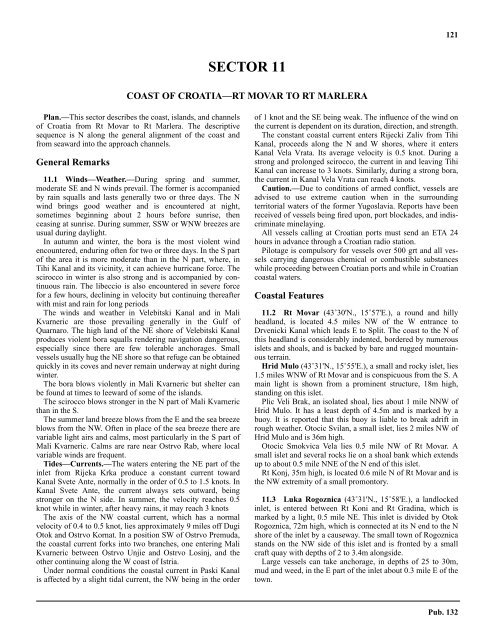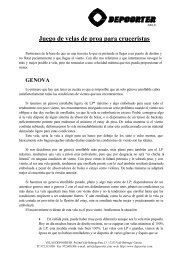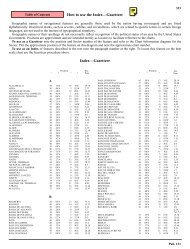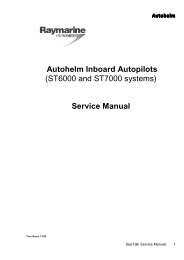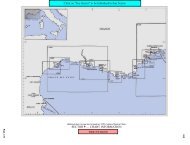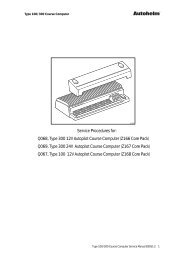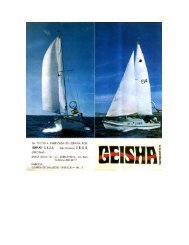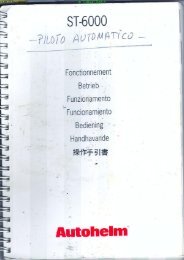You also want an ePaper? Increase the reach of your titles
YUMPU automatically turns print PDFs into web optimized ePapers that Google loves.
121SECTOR 11COAST OF CROATIA—RT MOVAR TO RT MARLERA11.0 Plan.—This sector describes the coast, islands, and channelsof Croatia from Rt Movar to Rt Marlera. The descriptivesequence is N along the general alignment of the coast andfrom seaward into the approach channels.General Remarks11.1 Winds—Weather.—During spring and summer,moderate SE and N winds prevail. The former is accompaniedby rain squalls and lasts generally two or three days. The Nwind brings good weather and is encountered at night,sometimes beginning about 2 hours before sunrise, thenceasing at sunrise. During summer, SSW or WNW breezes areusual during daylight.11.1 In autumn and winter, the bora is the most violent windencountered, enduring often for two or three days. In the S partof the area it is more moderate than in the N part, where, inTihi Kanal and its vicinity, it can achieve hurricane force. Thescirocco in winter is also strong and is accompanied by continuousrain. The libeccio is also encountered in severe forcefor a few hours, declining in velocity but continuing thereafterwith mist and rain for long periods11.1 The winds and weather in Velebitski Kanal and in MaliKvarneric are those prevailing generally in the Gulf ofQuarnaro. The high land of the NE shore of Velebitski Kanalproduces violent bora squalls rendering navigation dangerous,especially since there are few tolerable anchorages. Smallvessels usually hug the NE shore so that refuge can be obtainedquickly in its coves and never remain underway at night duringwinter.11.1 The bora blows violently in Mali Kvarneric but shelter canbe found at times to leeward of some of the islands.11.1 The scirocco blows stronger in the N part of Mali Kvarnericthan in the S.11.1 The summer land breeze blows from the E and the sea breezeblows from the NW. Often in place of the sea breeze there arevariable light airs and calms, most particularly in the S part ofMali Kvarneric. Calms are rare near Ostrvo Rab, where localvariable winds are frequent.11.1 Tides—Currents.—The waters entering the NE part of theinlet from Rijeka Krka produce a constant current towardKanal Svete Ante, normally in the order of 0.5 to 1.5 knots. InKanal Svete Ante, the current always sets outward, beingstronger on the N side. In summer, the velocity reaches 0.5knot while in winter, after heavy rains, it may reach 3 knots11.1 The axis of the NW coastal current, which has a normalvelocity of 0.4 to 0.5 knot, lies approximately 9 miles off DugiOtok and Ostrvo Kornat. In a position SW of Ostrvo Premuda,the coastal current forks into two branches, one entering MaliKvarneric between Ostrvo Unjie and Ostrvo Losinj, and theother continuing along the W coast of Istria.11.1 Under normal conditions the coastal current in Paski Kanalis affected by a slight tidal current, the NW being in the orderof 1 knot and the SE being weak. The influence of the wind onthe current is dependent on its duration, direction, and strength.11.1 The constant coastal current enters Rijecki Zaliv from TihiKanal, proceeds along the N and W shores, where it entersKanal Vela Vrata. Its average velocity is 0.5 knot. During astrong and prolonged scirocco, the current in and leaving TihiKanal can increase to 3 knots. Similarly, during a strong bora,the current in Kanal Vela Vrata can reach 4 knots.Caution.—Due to conditions of armed conflict, vessels areadvised to use extreme caution when in the surroundingterritorial waters of the former Yugoslavia. Reports have beenreceived of vessels being fired upon, port blockades, and indiscriminateminelaying.11.1 All vessels calling at Croatian ports must send an ETA 24hours in advance through a Croatian radio station.11.1 Pilotage is compulsory for vessels over 500 grt and all vesselscarrying dangerous chemical or combustible substanceswhile proceeding between Croatian ports and while in Croatiancoastal waters.Coastal Features11.2 Rt Movar (43˚30'N., 15˚57'E.), a round and hillyheadland, is located 4.5 miles NW of the W entrance toDrvenicki Kanal which leads E to Split. The coast to the N ofthis headland is considerably indented, bordered by numerousislets and shoals, and is backed by bare and rugged mountainousterrain.11.2 Hrid Mulo (43˚31'N., 15˚55'E.), a small and rocky islet, lies1.5 miles WNW of Rt Movar and is conspicuous from the S. Amain light is shown from a prominent structure, 18m high,standing on this islet.11.2 Plic Veli Brak, an isolated shoal, lies about 1 mile NNW ofHrid Mulo. It has a least depth of 4.5m and is marked by abuoy. It is reported that this buoy is liable to break adrift inrough weather. Otocic Svilan, a small islet, lies 2 miles NW ofHrid Mulo and is 36m high.11.2 Otocic Smokvica Vela lies 0.5 mile NW of Rt Movar. Asmall islet and several rocks lie on a shoal bank which extendsup to about 0.5 mile NNE of the N end of this islet.11.2 Rt Konj, 35m high, is located 0.6 mile N of Rt Movar and isthe NW extremity of a small promontory.11.3 Luka Rogoznica (43˚31'N., 15˚58'E.), a landlockedinlet, is entered between Rt Koni and Rt Gradina, which ismarked by a light, 0.5 mile NE. This inlet is divided by OtokRogoznica, 72m high, which is connected at its N end to the Nshore of the inlet by a causeway. The small town of Rogoznicastands on the NW side of this islet and is fronted by a smallcraft quay with depths of 2 to 3.4m alongside.11.3 Large vessels can take anchorage, in depths of 25 to 30m,mud and weed, in the E part of the inlet about 0.3 mile E of thetown.Pub. 132


